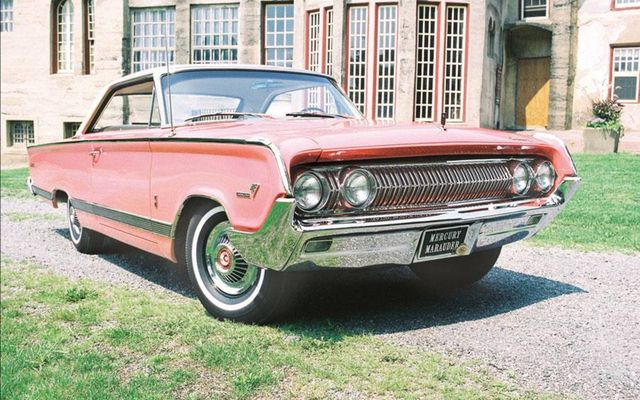In 1963, Mercury re-discovered performance. The base-level six-cylinder engine that the full-size Merc shared with Ford, along with the 292-cid and 352-cid V8s, were dropped, so power choices started with a 250-hp 390. Lincoln-Mercury racing veteran Bill Stroppe was hired to field a factory stock-car team.
Oddly, then, 1963 also marked Mercury's revival of the reverse-slanted Breezeway rear window--great for ventilation, questionable for aesthetics and awful for high-speed aerodynamics.
Ford Division boxed itself in by adopting formal rooflines derived from the Thunderbird. In 1962, Ford tried unsuccessfully to sneak past NASCAR officials with the Starlift, a removable hardtop for Galaxie convertibles. A better solution arrived in mid-'63, when both Ford and Mercury released fixed hardtops with fastback styling. Mercury called its version the Marauder, and it lived up to the name.
Stroppe figured that the Marauder roof was worth 4.5 mph, for maybe more than 160 at the top end, when powered by Ford's new 410-hp, 427-cid V8 (also called the Marauder when installed in a Mercury). In January 1963, Troy Rutt-man was third in NASCAR's revived Riverside 500. Then Parnelli Jones drove a Stroppe Marauder up Pikes Peak in record time in ‘63 and again in ‘64, while also clinching the 1964 USAC stock-car championship.
Mercury added a four-door Marauder for ‘64 and brought back the Park Lane label for a max-deluxe model featuring walnut-grained inner doors. Philip Christ's Long Island, N.Y., neighbor bought a new Park Lane Marauder. About 20 years later, after Christ moved to Pennsylvania, the neighbor's son called and offered him the car. With restorer John Dorner, Christ returned the old Merc to AACA Senior-award condition. At 120 inches, the Mercury's wheelbase is just an inch longer than a full-size Ford's, and while most of its lower sheetmetal is different, its greenhouse and interior are shared--except for the seat covers, trim and some additional gauges packed into a Ford dashboard.
Getting in requires ducking under the low Marauder roof-line, which also forces a Vista-Vision view through the windshield. Front-seat space is generous, as are the proportions of the optional vinyl buckets. The three-spoke steering wheel feels substantial for an era when skinny and dainty were the norm.
The throttle pedal requires a firm push but returns brisk acceleration, accompanied by a sub- dued throb from the 300-hp, four-barrel 390 and facilitated by the smooth-shifting automatic gearbox. The steering responds with precision, and the ride is controlled, though both feel detached from the road.
Mercury retired the Ma-rauder badge after 1965 but has more than once recalled it for duty on a high-style and/or high-performance model.
